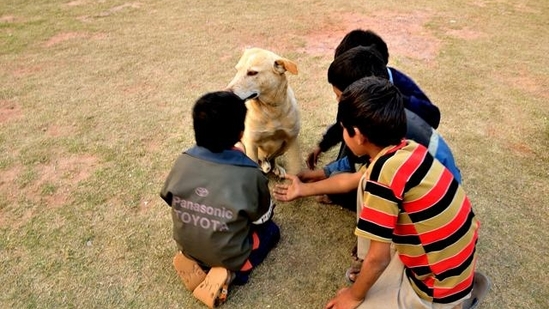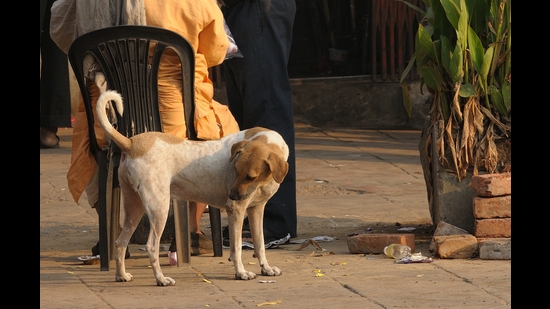Essay: First roti to the cow; first bite to the dog
A middle-aged man in a village in western Uttar Pradesh feeds stray dogs, a normal practice in his community. Dogs are an integral part of our culture.
Imagine the scene, a middle-aged man comes home after a long day at work. Along with his wife, children, and an old mother, there are two stray dogs waiting for him. They are sitting quietly in a corner of the courtyard. The man washes his hands and dries them with the towel his wife gives him. Then, he sits down on the charpoy to eat. His daughter brings him a shiny brass thali of food. The dogs start wagging their tails. The man tears the roti in two, looks at the dogs, and gives each a piece. Holding their treat in their mouths, they walk out into the street, wagging their small tails.


My grandmother described this scene to me with fondness whenever she talked about her ancestral village in western Uttar Pradesh (UP). She had been married for more than 50 years, by then. Yet, when she said “my village”, I knew it always meant her parent’s house, the house where she had spent her childhood. The description was so vivid that I could imagine the whole scene perfectly. I even imagined the colour of the two dogs, one black and one beige. The black one was a little taller than his companion. Both had small curly tails. At that point, I had only seen stray dogs and other animals on city roads and was scared of them.
“Weren’t you and others in the family scared of the dogs? They could have bitten you.”

Grandmother smiled as if I had said something funny: “They came for their share of food. Dogs only bite someone if they feel threatened or if they are nervous about the safety of their babies. In our family, the first roti made in the house was for the cow and the first bite from the plate was for the dog.”
This was the norm for most families in that village.
My mother too lived in a village in western UP for the first nine years of her life. Her family moved to the city more than seven decades ago, yet she talks about her village years fondly. She told how whenever a dog had a litter, the village kids took a broken terracotta pot and visited houses in the neighbourhood, singing, “Kutiya byahi choon de, gadha byaha noon de (the bitch has given birth to a litter, give some flour for her, and give salt for the mother donkey). The second part of the sentence was just tagged on because it rhymed, she said. The children would collect flour from five or six houses and an adult would add a small piece of jaggery. Then, a small brick stove would be made in a corner of the street, twigs would be placed in it and the flour and jaggery would be cooked in the broken pot. For two days, the mother dog was fed this concoction. If the dog gave birth in winter, the children made her a small covered shelter. My mother was sad that she could not be a part of that gang of dog lovers as her parents didn’t allow her to play in the street. She wouldn’t admit it but perhaps there was a caste angle to her not being allowed to mingle with those children.

Culturally, dogs have been an integral part of our lives. Not just dogs, many stray animals can be seen even at our sacred places. They are given food and shelter, and they rarely bother visitors. The Mahabharata starts with the story of a dog and ends with Yudhishtir insisting on taking his fellow traveller, a stray dog, with him to heaven. As everyone familiar with the epic knows, Yudhishtir’s canine companion who persisted with him even as his wife and brothers fell by the wayside, was Dharma himself, in the guise of a stray dog.
The G20 is a huge event, which will probably have many ramifications. Sadly, one of the unforeseen ones is the displacement of the city’s strays. Street dogs from different areas in Delhi especially those near the G20 venue have been removed

That the dog is man’s best friend is well known. They have lived alongside us for centuries. Yes, there are instances of street dogs attacking children and adults and barking at them aggressively, but there is no overnight solution to the issue. You may like them, hate them or ignore them. But we need to find ways to live with them. A balance has to be maintained between the safety of people and animal rights. There are very few cases of stray dogs attacking people in villages. Why is the conflict mostly in urban areas? I asked my mother about this.
“They did fight amongst themselves,” she said.
“How do you know, you left your village when you were nine.”
“There are still some people I know, who live in the village,” she said in an irritated tone.
“There were rare cases of biting when the dogs felt threatened. One of my cousins had to get injections when she was bitten. It was a mad dog; otherwise usually they don’t bite,” she said.

The truth is, you can’t wish stray dogs away. As Mahatma Gandhi said, “The greatness of a nation and its moral progress can be judged by the way its animals are treated”.
The earth belongs to all the creatures of the world.
Prerna Jain is an artist and photographer based in New Delhi. An extensive collection of her work can be found at her website www.prernasphotographs.com and at facebook.com/prernasphotographs. She is the author of My Feathered Friends and a collection of short stories, Stories Usual, Yet Unusual.
All Access.
One Subscription.
Get 360° coverage—from daily headlines
to 100 year archives.



HT App & Website







